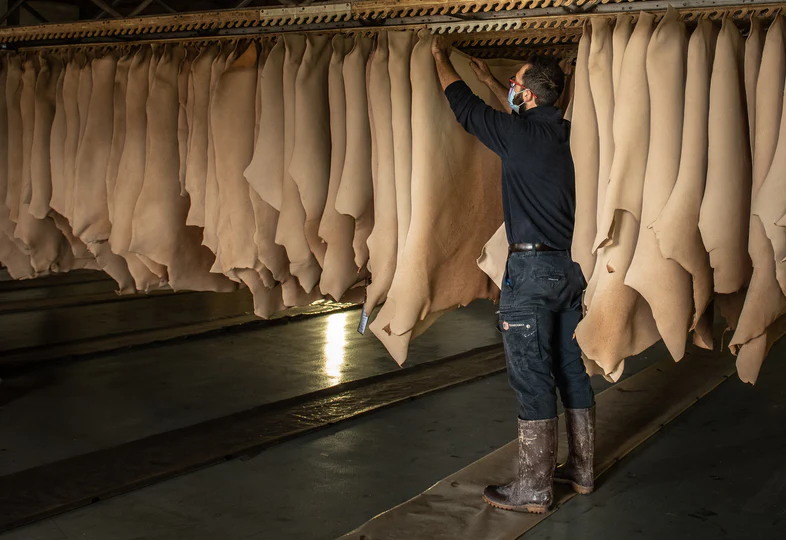Leather. The word itself brings to mind richness, heritage, and undeniable class. In luxury goods, leather is often the defining material. Its timeless appeal, sensory richness, and enduring quality make it a favorite for designers, brands, and consumers who want the best. Understanding this is vital for anyone involved in creating or appreciating luxury products. It’s the foundation of true quality.
This article will explore why leather holds such a high position in the luxury world. We’ll look at its history, unique characteristics, the craftsmanship involved, and the different types of leather used in luxury goods.
So, if you’re a designer, product developer, brand manager, or a discerning consumer, this guide is for you. You’ll gain insights to understand, select, and use high-quality leather.
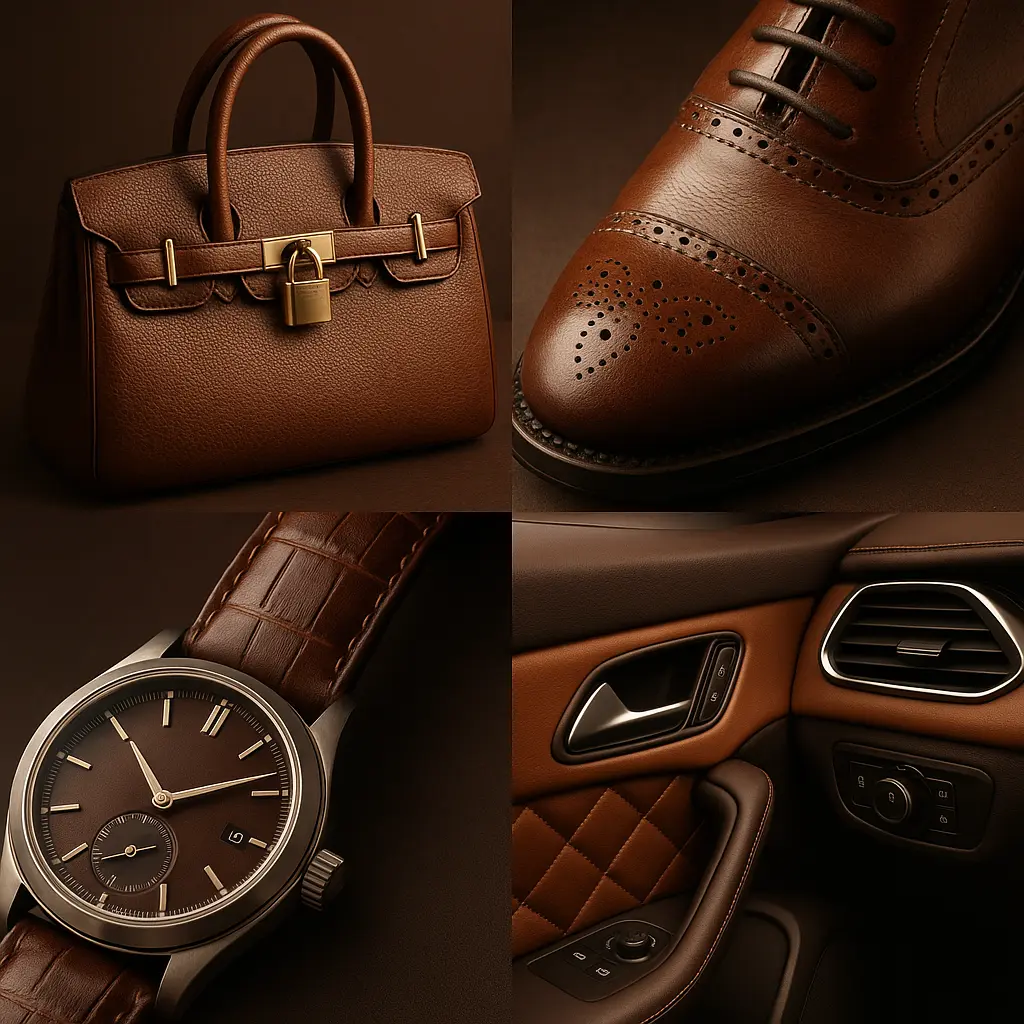
The prestige of leather isn’t a new trend. It’s woven into history, showing its lasting appeal. This historical significance elevates any modern product made from it, linking it to a legacy of exclusivity. For those in design or brand management, this inherent story is a powerful asset.
Leather’s Historical Significance in Luxury
Leather’s deep connection with luxury is a legacy meticulously built over centuries. From ancient courts to Renaissance workshops and modern fashion houses, leather has consistently been chosen for items signifying status, protection, and beauty. Understanding this history helps explain why leather remains a premium material—it has a cultural significance that outlasts trends.
Ancient Beginnings: Leather’s Early Prestige
Ancient civilizations like the Egyptians, Greeks, and Romans valued leather. They used it for essential footwear, practical clothing, formidable armor, durable travel accessories, fine furniture, and even sacred manuscript bindings. Critically, it was the rich and elite of these societies who adorned themselves with richly decorated leather garments, establishing an early and lasting association between leather and high status.
Leather’s role in fashion, as noted in historical accounts, “dates back thousands of years”. This wasn’t just about utility; even then, the ability to wear “richly decorated leather garments” was a clear indicator of one’s standing.
Medieval and Renaissance: Craftsmanship and Symbolism
As societies evolved, so did the appreciation for leather. During the Middle Ages, leather’s connection to luxury became even more pronounced. It was meticulously crafted into elaborate outfits for the nobility and fashioned into ornate horse tack for knights, showcasing the material’s capacity for refinement and artistry.
The Renaissance saw leather ascend to new heights. It was a “prized material for luxury garments” donned by nobles and the affluent bourgeoisie, often embellished with intricate embroidery and metallic ornaments. Glovemaking, in particular, transformed into a highly respected craft, with soft, perfumed leather gloves becoming potent symbols of wealth and social standing.
This period demonstrates a fascinating societal shift. As basic needs were met, the focus expanded towards craftsmanship and material quality for aesthetic and symbolic purposes. Leather became a prime medium for expressing these evolving human aspirations.
Modern Fashion: An Enduring Embrace
The 20th century heralded another significant evolution. Visionary designers like Coco Chanel and Elsa Schiaparelli boldly incorporated leather into their haute couture collections, definitively transitioning it from a primarily functional material to an undeniable fashion statement.
The post-war era witnessed a surge in leather’s popularity, as Hollywood icons and rock stars adopted leather jackets and boots, cementing its status as a symbol of both rebellion and high fashion.
Today, leather remains firmly at the forefront of luxury fashion. It is continuously reinvented by leading designers and prestigious houses such as Mulberry, Burberry, Louis Vuitton, and Ted Baker, who utilize its unique properties to create iconic handbags, footwear, and accessories. The consistent association of leather with elite groups across these diverse eras has solidified its aspirational value.
Expert Tip: Leather’s historical reverence isn’t just a quaint fact; it’s a powerful branding tool. When you choose leather, you’re choosing a material with an inherent story of prestige that resonates deeply with consumers.
The Inherent Qualities of Leather
Beyond its rich history, leather possesses an unparalleled combination of tangible and intangible qualities that make it inherently luxurious. These are the practical, sensory, and aesthetic reasons why designers, product developers, and discerning consumers consistently choose it. Understanding these core characteristics is crucial for anyone looking to create or identify truly exceptional luxury goods.
A. Durability and Longevity
One of leather’s most celebrated attributes is its exceptional strength and resilience. High-quality leather is built to endure, often outlasting other materials by years, if not decades. It’s inherently resistant to tears and the rigors of daily use, making it a profoundly practical choice for items that are meant to be lived with.
As a material, “properly cared for leather can withstand the test of time”. This isn’t just about looking good; it’s about lasting value. Luxury, after all, “isn’t just about appearance; it’s also about quality and longevity”. Consequently, well-crafted leather goods are not mere purchases but worthwhile investments that can reduce waste and the need for frequent replacements.
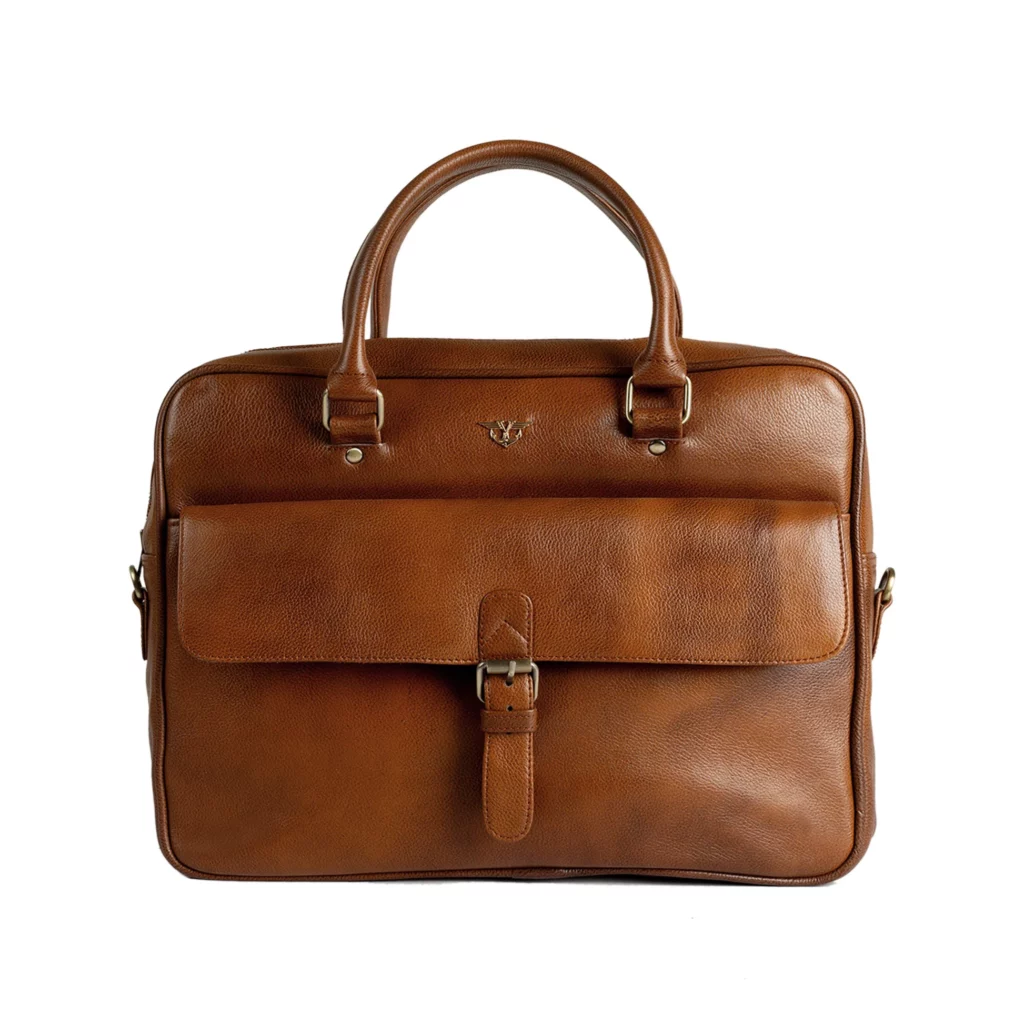
B. The Beauty of Patina
This is where leather truly distinguishes itself. High-quality leather, particularly full-grain leather, doesn’t just wear out; it wears in. Over time and with use, it develops a unique patina – a subtle sheen, a deepening of color, and an accumulation of character that enhances its beauty and tells a story. This transformative process is what makes a leather item deeply personal and increasingly cherished.
What contributes to this beautiful aging? It’s the culmination of everyday use: the oils from your hands, ambient dirt and dust, sunlight, and the minor scuffs and spills that mark a life well-lived. As one source eloquently puts it, “How many things do you own that get better with age? Leather is almost alive… Patina is what happens when leather ages gracefully and is entirely unique to natural products”.
Crucially, this ability to develop a rich patina is a hallmark of high-quality leather. Cheaper, heavily processed leathers often crack, peel, or degrade, lacking the natural integrity to age with such elegance. The patina, therefore, is more than just an aesthetic feature; it’s an indicator of superior material and processing.
C. Aesthetic Excellence
Leather possesses an intrinsic natural elegance that is incredibly difficult, if not impossible, to replicate artificially. Each hide comes with its own unique grain, subtle texture variations, and inherent warmth, ensuring that no two leather products are ever truly identical.
Its rich texture and depth of color lend an immediate air of sophistication. Furthermore, leather can be dyed in a virtually limitless spectrum of colors, from deep, classic mahogany hues and timeless blacks to vibrant reds and contemporary pastels. Beyond color, the ability to be embossed, tooled, and intricately stitched opens up a world of design possibilities, allowing for brand-specific finishes and detailed artistry.
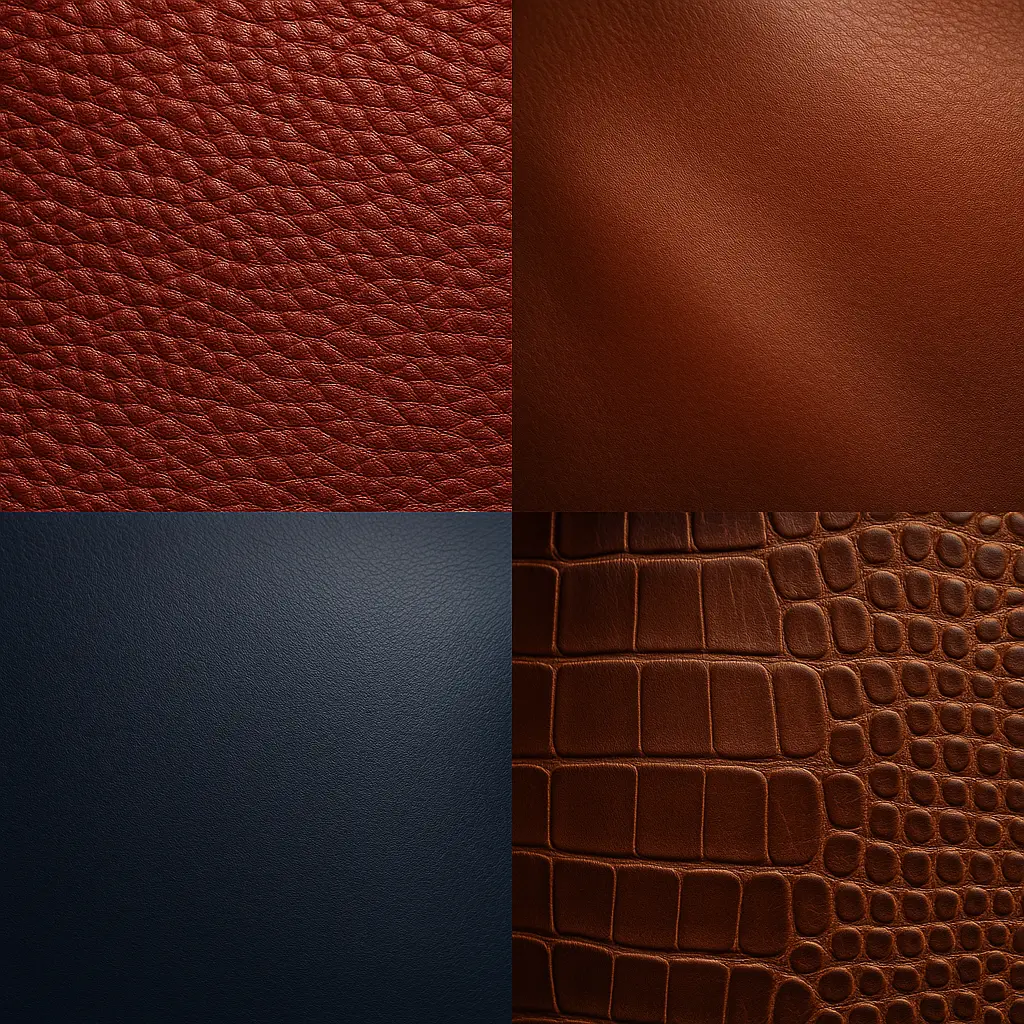
D. The Tactile Experience
The feel of genuine leather is simply unparalleled. Its characteristic suppleness, inviting smoothness, comforting warmth, and overall sensory richness contribute profoundly to its luxurious appeal. This is a critical differentiator in the luxury market, as synthetics often struggle to authentically replicate this complex tactile experience.
Running your fingers across a high-quality leather item is a sensory experience that immediately elevates its perceived value. As noted by experts in luxury branding, “Luxury brands know that the customer experience begins with touch… The texture, weight, and feel of an item set the tone for the entire experience”. This tactile pleasure does more than just feel good; it builds an emotional connection with the product and fosters trust in the brand’s commitment to quality.
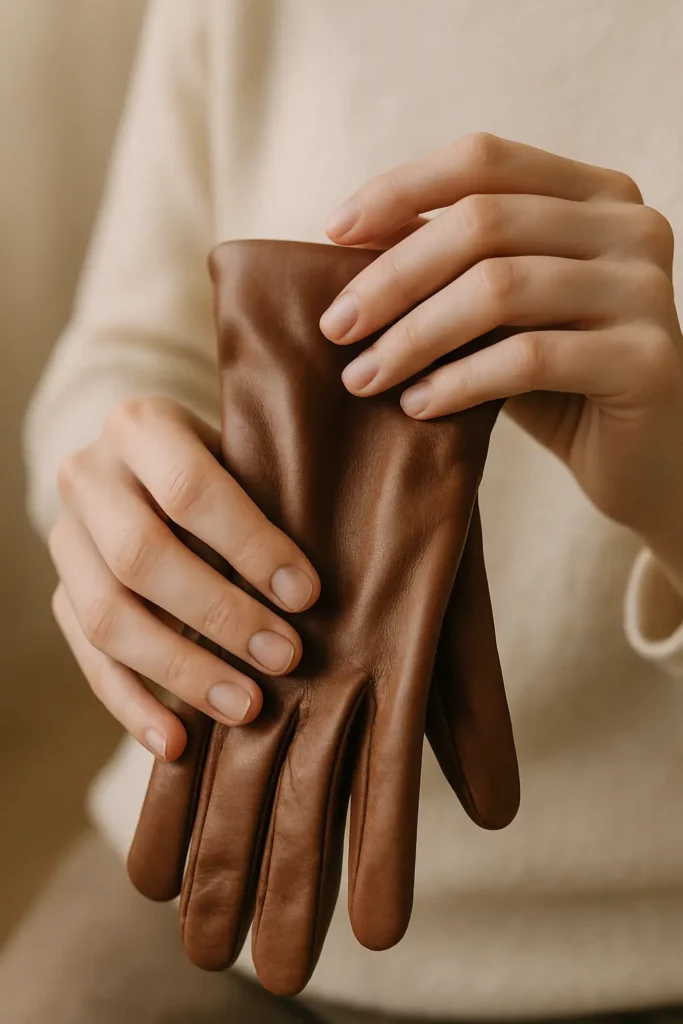
E. Versatility in Application
Leather’s adaptability is truly remarkable. It can be engineered to be soft and supple for delicate gloves or tough and rugged for durable boots. This versatility allows it to be a cornerstone material across an astonishingly diverse range of luxury goods, including fashion items like iconic handbags and shoes, statement jackets, and accessories. It’s also found in luxurious furniture and furnishings such as sofas and armchairs. Premium automotive interiors often feature leather for seats and dashboards. Stylish and durable travel accessories and luggage also benefit from leather’s qualities.
This widespread presence in various high-value sectors reinforces leather’s universal recognition as a symbol of quality and prestige.
F. Comfort and Breathability
An often-overlooked yet crucial characteristic of genuine leather is its natural breathability. Unlike many synthetic materials that can trap heat and moisture, leather allows air to circulate, helping to regulate temperature. This makes it exceptionally comfortable for items worn close to the body, such as shoes, garments, and even watch straps, providing warmth in cooler conditions and allowing for ventilation when it’s warmer.
Key Consideration: While leather offers a wealth of benefits, understanding the specific type and grade is paramount. Not all leather is created equal, and these distinctions significantly impact the final product’s luxury appeal, performance, and longevity.
The Importance of Craftsmanship in Luxury Leather Goods
The journey of a luxurious leather item from a raw hide to a finished masterpiece is an art form in itself, profoundly reliant on the skill, precision, and unwavering dedication of master artisans. This human element, the artisan’s touch, is not merely a step in production; it’s a significant contributor to the intrinsic value, soul, and exclusivity of these coveted goods. It’s what separates true luxury from mass-produced alternatives.
Meticulous Attention to Detail
In the world of luxury leather, compromise is not an option. Every single stitch, cut, and finish is executed with painstaking precision and profound care. Often, hand-stitching is the preferred method, not just for its aesthetic appeal but for its superior precision and enhanced durability—a time-honored, labor-intensive process that demands immense skill and patience.
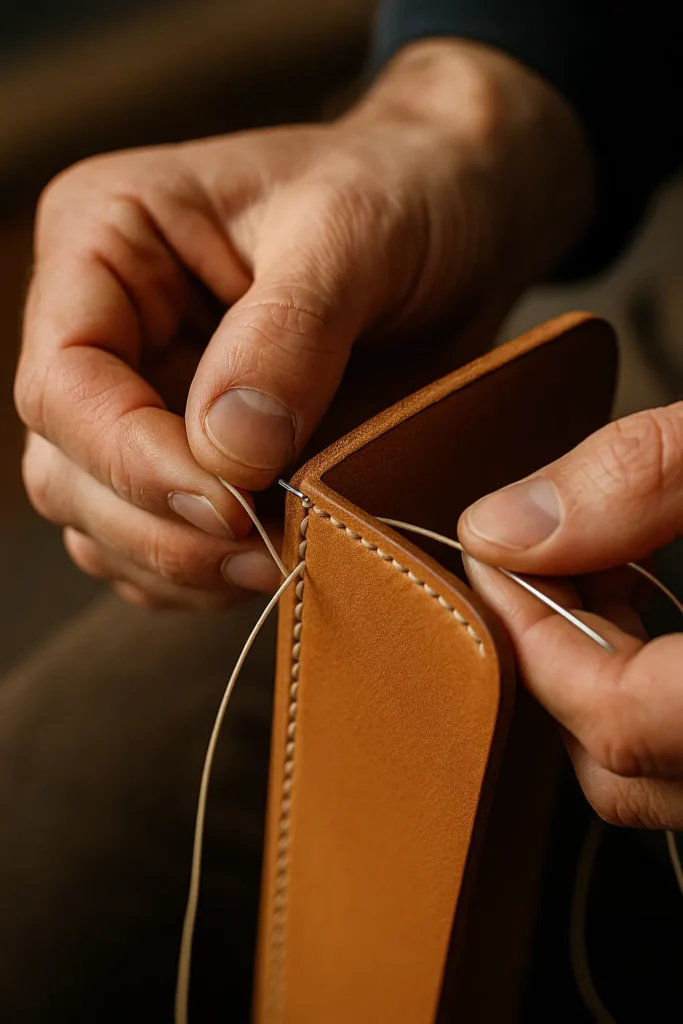
The Mastery of Skilled Artisans
Behind every exquisite leather piece are master craftspeople who have dedicated years, often decades, to honing their specialized skills. Many esteemed luxury brands are custodians of traditional craftsmanship techniques, carefully preserving and passing these invaluable skills down through generations, ensuring that the art of fine leatherworking endures. This dedication to human skill and meticulous labor inherently limits production volume and elevates costs, positioning these items as truly exclusive.
Time-Consuming Processes
From the initial selection and preparation of the hide through the intricate stages of tanning, cutting, assembling, and finishing, luxury leather goods undergo exceptionally labor-intensive processes that require significant patience and expertise. This deliberate, unhurried approach stands in stark contrast to the rapid, automated methods of mass production.
Commitment to Finest Materials
The artisan’s commitment extends to the very components they work with. There is a deep understanding that true luxury cannot be achieved with substandard materials. Therefore, artisans meticulously select only the finest leathers, the most durable threads, and the highest quality hardware.
Bespoke and Customization
Elevating the luxury experience further, many high-end leather brands offer bespoke services and customization options. This allows clients to commission pieces tailored to their exact specifications, from monograms and bespoke colorways to entirely unique designs. This level of personalization transforms a luxury good into a deeply personal statement and a co-created experience, fostering a profound emotional connection.
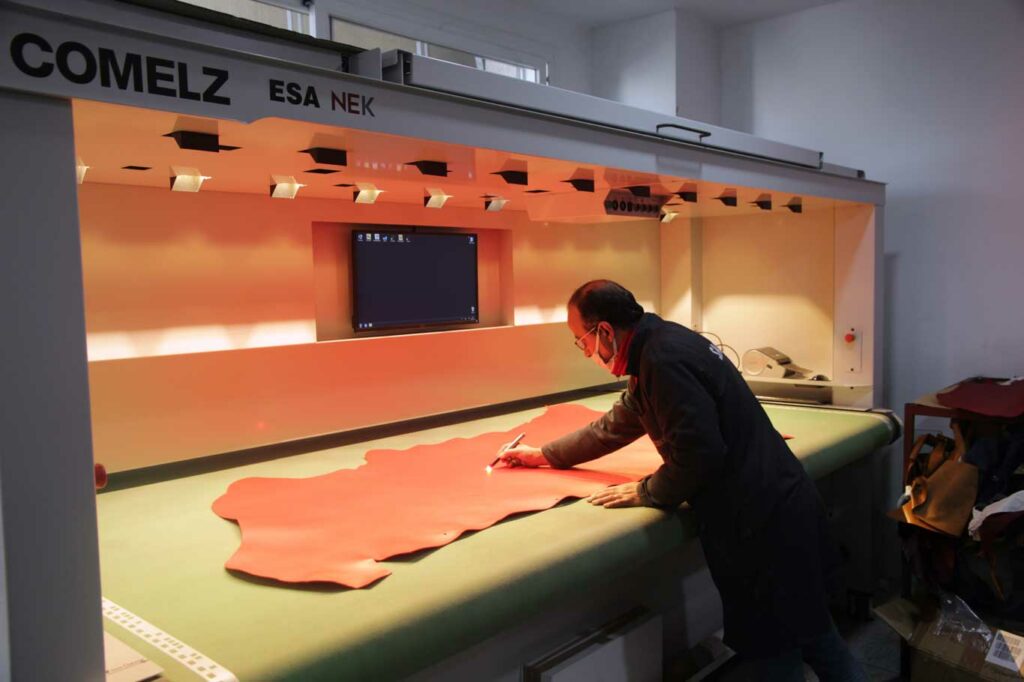
Unyielding Quality Control
Finally, to ensure that every piece that leaves the workshop meets the brand’s exacting standards, rigorous quality control checks are implemented at multiple stages of the production process. This unwavering commitment to perfection ensures that the end consumer receives an item that is not only beautiful but also flawlessly crafted.
The preservation of these traditional craftsmanship techniques by luxury leather brands can also be seen as a form of cultural heritage conservation. In an increasingly automated world, the continuation of these manual skills represents a living connection to history and artistry.
Expert Tip: When evaluating a luxury leather good, look beyond the overall design. Examine the stitching – is it even, tight, and consistent? Feel the hardware – does it have a satisfying weight and smooth operation? Inspect the finishing of the edges – are they smooth, polished, or neatly painted? These details are the subtle signatures of true, time-honored craftsmanship.
Understanding Leather Grades and Types
The term “leather” encompasses a vast world of materials, each with its own distinct characteristics, strengths, and ideal applications. For anyone involved in luxury goods, understanding the different grades and types of leather is absolutely fundamental. This knowledge empowers you to appreciate why certain leathers are meticulously chosen for high-end products, how to identify genuine quality, and ultimately, how to make informed decisions.
A. Leather Grades
The grade of leather refers to which part of the animal hide is used and how it’s processed. This is a primary determinant of its quality, durability, and cost.
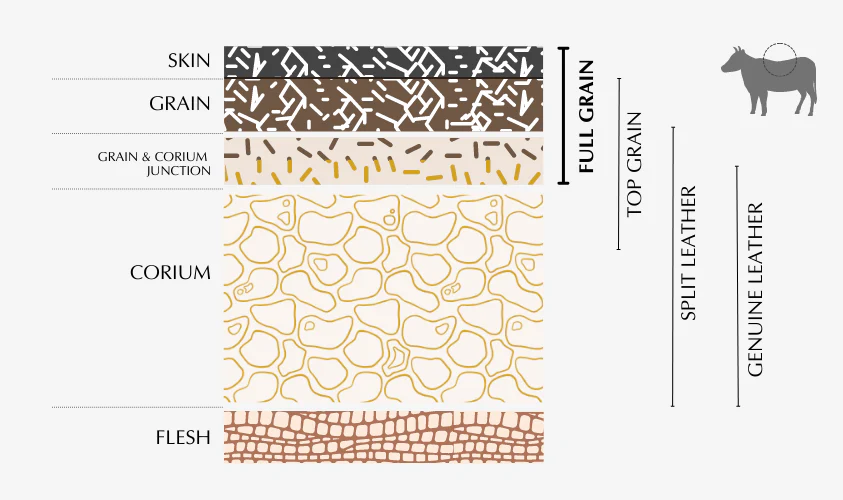
Full-Grain Leather: The Best Quality Universally recognized as the highest quality leather available, full-grain is made from the entire outer layer of the hide. It critically retains all its natural grain and surface texture, including unique markings like scars or wrinkles, which are considered hallmarks of authenticity. This makes it the most durable and breathable type, celebrated for developing a rich patina with age. Its benefits include exceptional strength, longevity, unique character, and a luxurious feel. Full-grain is the preferred choice for high-end furniture, premium footwear, heirloom bags, and durable accessories where these qualities are paramount.
To identify full-grain leather, look for natural imperfections like subtle scars or wrinkles, as these are positive indicators. Feel the texture; it should have a slightly uneven, natural graininess, not a perfectly smooth or plastic-like feel. The grain pattern will be pronounced and individual, not repetitive. Full-grain leather is generally denser and heavier, and it’s renowned for developing a rich patina with age and use.
Top-Grain Leather: Refined Surface Quality The second highest quality grade, top-grain also comes from the top cut of the hide, but its outermost layer is lightly sanded or buffed to remove imperfections, resulting in a smoother, more uniform surface appearance. It’s typically thinner and more pliable than full-grain. Top-grain still offers good durability (though less than full-grain), a consistent and often flawless appearance, and can be more stain-resistant if a protective coating is applied. It’s also generally more affordable than full-grain. This grade is widely used for handbags (like those by Latico Leathers ), small leather goods, garments, and upholstery where a pristine, uniform look and a softer initial feel are desired.
For identifying top-grain leather, note its smooth, uniform surface with fewer visible blemishes due to sanding. Some fine pores may still be visible. It usually feels soft and pliable and often has a polished look. Unlike full-grain, it does not typically develop a rich, complex patina, maintaining a more consistent appearance.
Other Grades (For Contrast) Split leather is derived from the lower layers of the hide and is less durable. It can be processed to create suede or used as a base for corrected-grain leather. Bonded leather, the lowest quality, is made from leather scraps and is not typically used in true luxury goods.
The strategic choice of leather grade by a luxury brand is a critical decision, influencing the product’s final aesthetic, resilience, consumer perception, and price point.
The “imperfections” in full-grain leather are often reframed as “hallmarks of authenticity” in luxury. These unique natural marks tell a story of genuine origin, valued by consumers seeking uniqueness over sterile perfection.
Table 1: Full-Grain vs. Top-Grain Leather – A Quick Comparison
| Feature | Full-Grain Leather | Top-Grain Leather |
|---|---|---|
| Origin (Hide Layer) | Outermost layer, entire grain structure intact | Outermost layer, top surface sanded/buffed |
| Surface Appearance | Natural, may have imperfections, unique character | Smooth, uniform, blemishes removed |
| Natural Markings | Visible (scars, wrinkles, pores) – considered authentic | Mostly removed or minimized |
| Durability | Highest, very strong and resilient | Durable, but less so than full-grain as some strong fibers may be removed |
| Patina Development | Develops a rich, beautiful patina over time | Does not develop a significant patina; maintains a more consistent look |
| Breathability | Most breathable | Good breathability, but potentially less than full-grain if heavily finished |
| Feel | Can be initially stiffer, softens with use; substantial | Softer from the start, more pliable |
| Typical Cost | Highest | Moderate to High (less than full-grain) |
| Common Luxury Uses | Heirloom-quality bags, premium footwear, fine furniture, rugged accessories | Fashion handbags, wallets, garments, upholstery requiring a uniform, sleek appearance |
Export to Sheets
B. Specialty Leathers
Beyond grades, specific types of animal hides are prized for their unique qualities in luxury applications.
Calfskin: Smooth Luxury Sourced from young cattle, calfskin is renowned for its exceptionally fine grain, luxurious softness, and supple feel, combined with impressive durability and a lightweight nature. Its tightly packed fibers contribute to its strength and smooth, polished appearance. Box Calf, a particularly esteemed type, is often chrome-tanned, characterized by its smooth, subtly glossy finish and a firm, structured hand, ideal for traditional men’s dress shoes and structured luxury handbags. Calfskin is a staple for high-end footwear (like Anuent shoes ), iconic luxury handbags (used in Hermès bags like the Kelly and Birkin ), premium wallets, and other fine small leather goods.
To identify calfskin, look for an extremely fine, smooth, and even grain pattern. It should feel exceptionally soft and supple, yet resilient, and generally lighter than cowhide. High-quality calfskin will exhibit minimal natural imperfections.
Lambskin (Nappa): Unmatched Softness Derived from young sheep, lambskin is celebrated for its extreme softness (often described as buttery), its lightweight nature, and its very fine grain. It is exceptionally pliable and drapes beautifully. Nappa leather often describes particularly soft, full-grain lambskin tanned to be exceptionally pliable and smooth. Lambskin is a favorite for ultra-luxury handbags (iconically used by Chanel for Classic Flaps and by Dior ), high-end jackets, delicate gloves, and small leather goods. The Intrecciato weave of Bottega Veneta heavily relies on Nappa lambskin. However, lambskin is inherently more delicate and prone to scratches and stretching, requiring careful handling.
For identifying lambskin, its exceptionally soft, buttery, and smooth touch is key. It’s noticeably lightweight, very flexible, features a very fine grain, and often has a subtle, velvety sheen.
Suede: Velvety and Casual Suede is crafted from the underside (flesh side) of a split piece of leather (often lamb, goat, calf, or pig), which is then buffed to create its characteristic soft, napped, velvety finish. It’s generally less durable than full-grain leather. Suede is popular for footwear (brands like Christian Louboutin use it for rich texture ), jackets, accessories, and linings. A key consideration is its porosity and susceptibility to staining and water damage, requiring specialized care.
To identify suede, look for its distinctive soft, fuzzy, and napped texture and matte appearance. It’s usually made from the flesh side of a split hide and feels more pliable and often thinner than full-grain leather.
Nubuck: Refined Velvet, More Durable Nubuck is a top-grain leather sanded on the grain side to create a very fine, short, velvety nap, similar to suede but typically more robust and durable. It’s frequently used for high-end footwear (like Timberland Premium boots ), bags, upholstery, and jackets. Like suede, nubuck is susceptible to staining and water spots, needing protective treatments.
Identifying nubuck involves looking for a velvety nap that’s finer, shorter, and denser than suede’s. It’s made from the grain side of top-grain leather and feels more robust than suede. A water drop test can also help: genuine nubuck typically absorbs water, temporarily darkening the area.
Exotic Leathers: Rare and Distinctive This category includes skins such as Crocodile, Alligator, Ostrich, Python, Lizard, Stingray, and Shell Cordovan. These are valued for their unique textures, distinctive scale patterns, rarity, and the statement of exclusivity they make, typically being the most expensive leathers. Shell Cordovan, a unique equine leather, is renowned for its smooth, non-porous surface, high shine, incredible durability, and characteristic aging with rolls rather than creases; Horween Leather Company is a famous producer. Exotic leathers are stars in ultra-luxury handbags (e.g., Hermès Birkin or Kelly in Crocodile, Alligator, or Ostrich ), high-end footwear (like Alden shoes in Horween Shell Cordovan ), and bespoke accessories. Ethical sourcing is a key consideration, with reputable brands focusing on traceable skins adhering to CITES regulations.
Identifying exotic leathers involves looking for specific patterns: Crocodile/Alligator skins have unique, irregular scales; alligator often features an umbilical scar, while crocodile scales may have a tiny pore. Ostrich leather’s key feature is the raised quill follicle pattern; uniformity might indicate imitation. For Python, you should feel individual, slightly raised scales with imperfect, non-repeating patterns. Lizard leather has small, closely spaced, granular scales and is generally thinner than crocodile. Shell Cordovan has an exceptionally smooth, non-porous, high-gloss surface and ages with rolls, not fine creases.
The choice of a specific leather type by a luxury brand is a strategic decision, directly shaping the product’s aesthetic, durability, consumer perception, and market position.
Understanding Leather Tanning and Finishing
The transformation of raw hide into luxury leather relies on tanning and finishing. These processes are fundamental in determining the leather’s final characteristics, resilience, feel, and visual allure. Understanding these techniques is crucial for specifying or selecting leathers.
A. Tanning Methods
Tanning is the chemical process that converts perishable hides into stable leather by altering the protein structure to prevent decomposition and impart desired qualities.
Vegetable Tanning (Veg-Tan): The Traditional Method This ancient method uses natural tannins from plant matter like oak or chestnut bark. It’s a slow process (30-60 days), soaking hides in increasingly concentrated tannin solutions. Veg-tan produces firm leather known for developing a beautiful patina and often has a sweet or earthy aroma with rich, natural earthy colors. Initially stiff, it softens with use and is highly breathable. It’s favored for high-end handmade goods, artisanal wallets, classic bags, and sturdy belts. Generally considered more environmentally friendly and biodegradable if managed well, though it uses significant water.
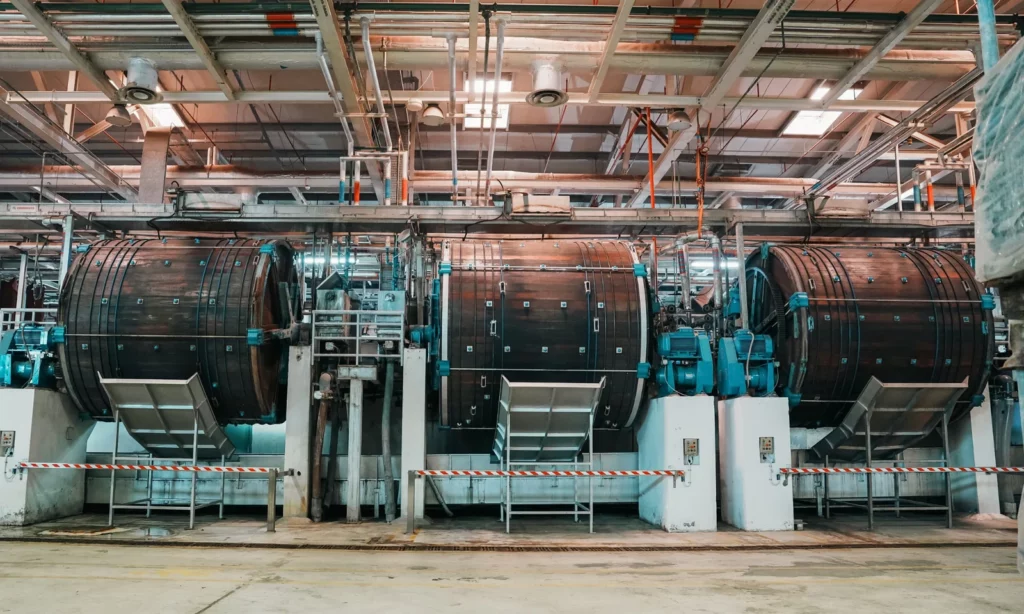
Chrome Tanning: Efficient and Versatile The most prevalent method (approx. 90% of leather production), it employs chromium salts. It’s much faster, often completed in a single day. This results in soft, supple, and flexible leather from the start, with excellent water resistance and color stability, allowing for a wider range of vibrant colors. It has higher tensile strength but is less likely to patina and may have a chemical smell. It’s extensively used in fashion apparel, upholstery, shoes, gloves, and automotive interiors. However, it raises environmental concerns due to chromium use and potential toxic wastewater if not managed well; the leather is not easily recyclable.
Aldehyde Tanning (Chrome-Free): The Modern Alternative This method uses aldehydes as a “chrome-free” alternative. It produces leather that is exceptionally soft and supple, with good water resistance and a lightweight nature. It retains natural color well and is stable against temperature fluctuations. It’s widely adopted by the automotive industry and used for fine garments and gloves. It can be a more eco-friendly alternative if safer aldehydes are used.
The choice between tanning methods reflects a brand’s ethos, product use, and client desires, balancing tradition with modern demands for performance and color.
Table 2: Vegetable Tanning vs. Chrome Tanning – Key Differences
| Feature | Vegetable Tanning | Chrome Tanning |
|---|---|---|
| Tanning Agents | Natural plant tannins (bark, leaves, roots) | Chromium salts (primarily chromium sulfate) |
| Process Time | Slow (30-60 days or more) | Fast (typically 1 day) |
| Feel/Softness | Can be initially stiff, softens beautifully with use | Soft and supple from the outset |
| Patina Development | Excellent, develops a rich and unique patina | Minimal to no natural patina development |
| Color Range | Rich, deep, natural earthy tones | Wide range of vibrant, consistent colors possible |
| Water Resistance | Lower, more susceptible to water staining | Higher, more water-resistant |
| Aroma | Distinct, pleasant, natural, earthy/sweet | Can have a chemical odor if not properly finished/aired |
| Environmental Impact | Generally lower if managed well, biodegradable | Higher due to chromium use, less biodegradable |
| Typical Cost | Higher | Lower |
| Best Luxury Apps. | Artisan goods, classic bags/wallets, belts, saddlery | Fashion apparel, footwear, upholstery, items needing color variety |
Export to Sheets
B. Finishing Methods
Once tanned, leather undergoes finishing processes to enhance aesthetics, provide protection, and modify texture and color.
Aniline Finish: Pure and Natural This most natural-looking finish uses soluble, transparent dyes that penetrate without coating the surface, preserving the hide’s original grain, pores, and unique markings. It offers the most natural look and softest feel, is highly breathable, and develops a rich patina. However, it’s the least resistant to staining, fading, and scratches. It’s reserved for highest-end furniture and premium accessories where natural beauty is paramount, using only the highest quality full-grain hides.

Semi-Aniline Finish: Beauty with Protection A compromise, aniline-dyed leather receives a thin protective topcoat, possibly with slight pigment. The surface might be slightly buffed. It retains much of the natural look and feel of aniline leather, allowing grain to show, but offers better durability and resistance to stains and wear. Color is more uniform, and it will develop a patina, though often less pronounced. It’s an excellent choice for high-use luxury furniture, premium car interiors, and frequently used handbags. [Image Placeholder: A semi-aniline leather car seat or a designer handbag, looking natural but with a subtle protective sheen and even color.]
Pigmented (Protected/Coated) Finish: Maximum Durability This finish applies a layer of opaque pigments and a polymer topcoat, covering most natural markings and creating a very uniform surface. It offers the highest durability and protection, highly resistant to stains, scratches, and fading. Color is very uniform. However, it’s less breathable, can feel stiffer or artificial, and does not develop a natural patina. It’s ideal for family-friendly luxury furniture, daily driver car upholstery, and high-wear accessories.
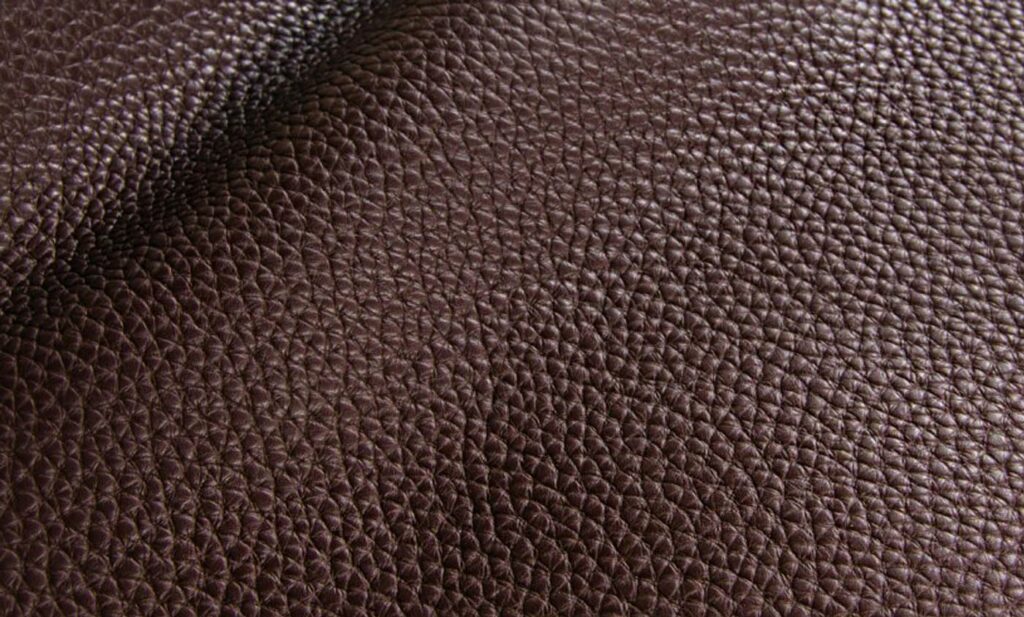
The choice of tanning and finishing dictates the leather’s journey. Veg-tanned aniline leather invites a relationship of evolving character, while chrome-tanned pigmented leather offers consistent resilience. Increasing consumer awareness of environmental impacts is compelling luxury brands towards greater transparency and responsibility.
Table 3: Leather Finishes Compared – Aniline vs. Semi-Aniline vs. Pigmented
| Feature | Aniline Finish | Semi-Aniline Finish | Pigmented Finish |
|---|---|---|---|
| Process | Soluble dyes, no surface coating | Light protective coating, may have slight pigment | Opaque pigments & polymer topcoat |
| Natural Appearance | Fully visible grain & markings | Most grain & markings visible | Natural grain/markings mostly or fully obscured |
| Feel/Softness | Softest, most natural feel | Soft, natural feel, slightly less than aniline | Can feel stiffer, less natural, surface coating is felt |
| Durability (Stain/Scratch) | Lowest resistance | Moderate resistance | Highest resistance |
| Patina Development | Excellent, develops rich patina | Good, develops patina (less pronounced than aniline) | Minimal to no natural patina |
| Breathability | Highest | Good | Lowest |
| Maintenance Required | High, needs careful cleaning & conditioning | Moderate, more forgiving than aniline | Low, easy to wipe clean |
| Typical Cost | Highest | High | Moderate to High (can vary) |
| Ideal Luxury Use Cases | Ultra-high-end items, well-cared for furniture/accessories | Everyday luxury furniture, car interiors, handbags, footwear | High-wear items, family use, items needing vibrant/consistent color |
Export to Sheets
Key Consideration: Tanning and finishing fundamentally define leather’s character and performance. Vegetable-tanned aniline leather offers the most natural experience but needs care. Chrome-tanned pigmented leather provides robust performance but sacrifices some natural charm.
Leather in Iconic Luxury Products
Many iconic luxury products are defined by their specific leather choice, highlighting how a hide’s characteristics contribute to an item’s status and brand identity.
A. Handbags
Handbags particularly showcase luxury leather’s allure.
Hermès Birkin & Kelly bags are offered in various leathers like Togo (pebbled, scratch-resistant calfskin ), Clemence (softer, heavier baby bull calfskin with a wider grain ), Epsom (heat-pressed, rigid calfskin, scratch/water-resistant ), and classic Box Calf (smooth, glossy, firm calfskin that patinas beautifully ). Ultra-luxurious versions use exotics like Crocodile, Alligator , and Ostrich. Hermès selects these to offer varied experiences: Togo and Epsom for durability, Box Calf for classic elegance, and exotics for ultimate luxury. The choice also influences bag structure.
Chanel Classic Flap & 2.55 Reissue are famously made in Lambskin (buttery soft, smooth, velvety sheen, but delicate ) and Caviar (pebbled, durable, scratch-resistant calfskin that holds quilting well; Aged Calfskin is used for 2.55 Reissues for a vintage look ). Chanel offers a choice between ultimate softness (lambskin) and robust practicality (Caviar).
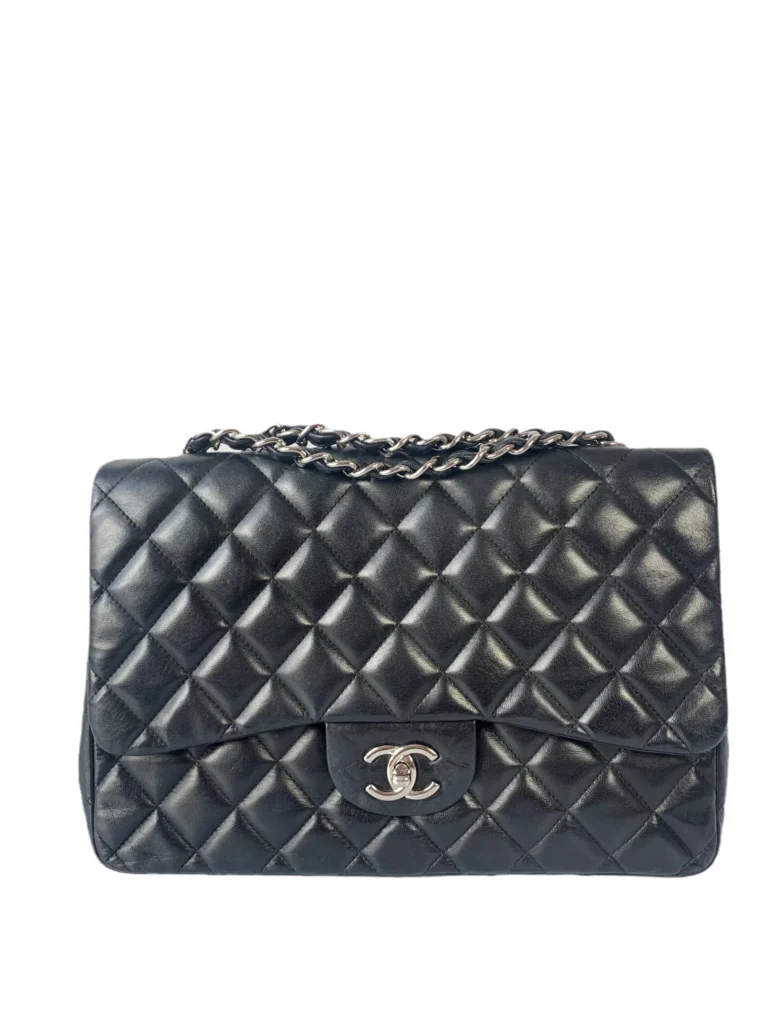
Prada Saffiano Leather Goods (e.g., Galleria Bag) feature a distinctive calf leather with a machine-pressed cross-hatch pattern and wax coating, making it exceptionally durable, scratch-resistant, water-resistant, and easy to clean. Saffiano, patented by Mario Prada, offers a unique, recognizable texture ideal for stylish yet practical luxury bags.
Louis Vuitton Epi Leather Goods (e.g., Alma, Noé, Twist) use calfskin embossed with a distinctive horizontal grain pattern (like wheat ears). It’s dyed vibrant colors and is known for durability, water resistance, and relative scratch resistance. Introduced in the 1980s (origins in 1920s ), Epi leather provides a unique textured aesthetic with robust performance, suiting everyday luxury and reinforcing Louis Vuitton’s blend of heritage and modernity.
Bottega Veneta Intrecciato Woven Bags most famously use Nappa Lambskin. This choice is due to Nappa’s extreme softness, thinness, and pliability, essential for the intricate hand-weaving that defines these bags. The Intrecciato weave is Bottega Veneta’s signature, and Nappa lambskin is one of few leathers suitable for such fine weaving.
B. Footwear
Leather’s role in luxury footwear is equally significant.
Christian Louboutin Shoes often utilize Suede for its luxurious nap and rich color, and Calfskin for smooth, structured designs.
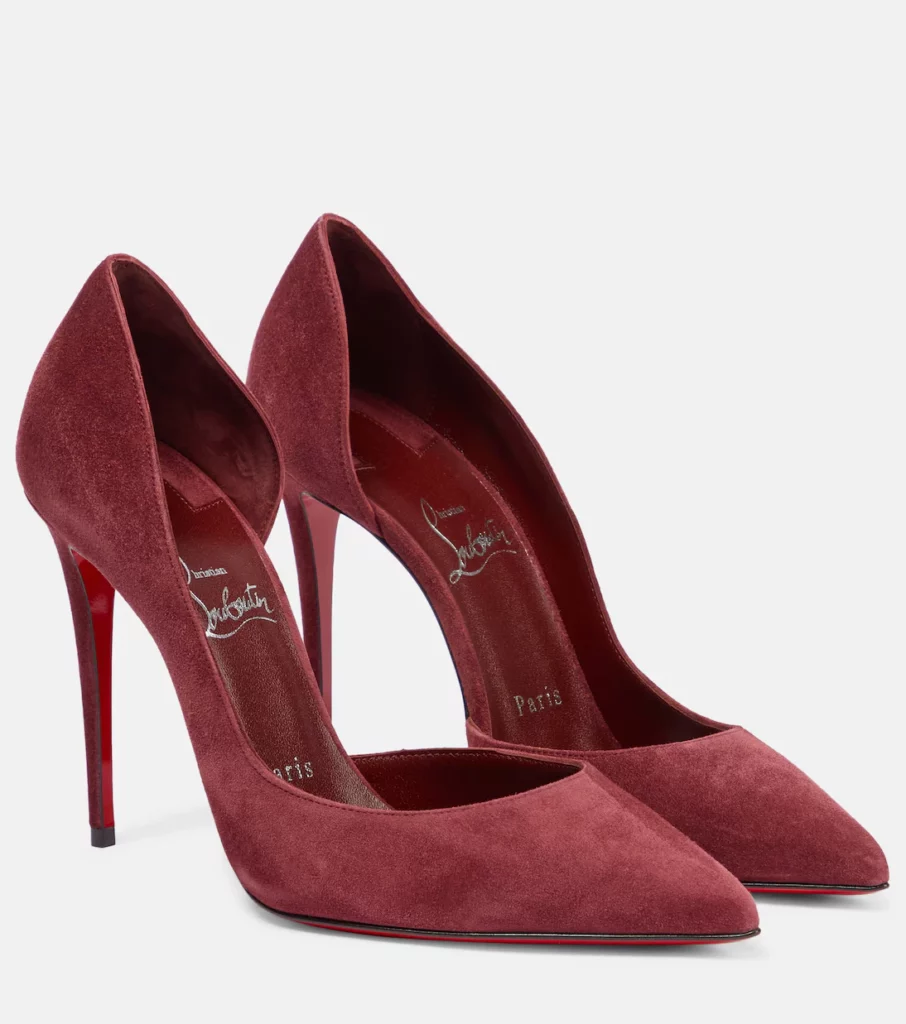
Alden Shoes (Horween Shell Cordovan) feature Shell Cordovan, a specific equine leather from a horse’s rump. It’s extremely durable, scuff-resistant, high-shine, and ages with smooth rolls/ripples. The Horween Leather Company’s tanning process is labor-intensive (≥6 months). Shell Cordovan is prized for crafting long-lasting, heirloom men’s dress shoes and boots.
Timberland Premium Boots often feature Nubuck leather. Nubuck offers a soft, velvety feel like suede but with enhanced durability (from top-grain), suitable for rugged yet stylish outdoor footwear.
C. Automotive Interiors
Luxury car cabins are often cocoons of fine leather.
Rolls-Royce uses only the finest bull hides, often Nappa full-grain leather, from animals raised in specific conditions for supple skin. The leather is tumbled in pigment for deep color saturation and even aging, and treated for a sumptuous texture and to remain silent. This reflects the brand’s commitment to ultimate luxury.
D. Small Leather Goods and Accessories
Even in smaller items, leather choice speaks volumes.
Lizard and Python Leather Belts, Wallets, Watch Straps are chosen for their unique scale patterns, flexibility, and exotic appeal. Lizard skin offers a refined texture, used by brands like Prada and Gucci. Python skin is prized for its recognizable patterns and softness with age, crafted into various accessories.
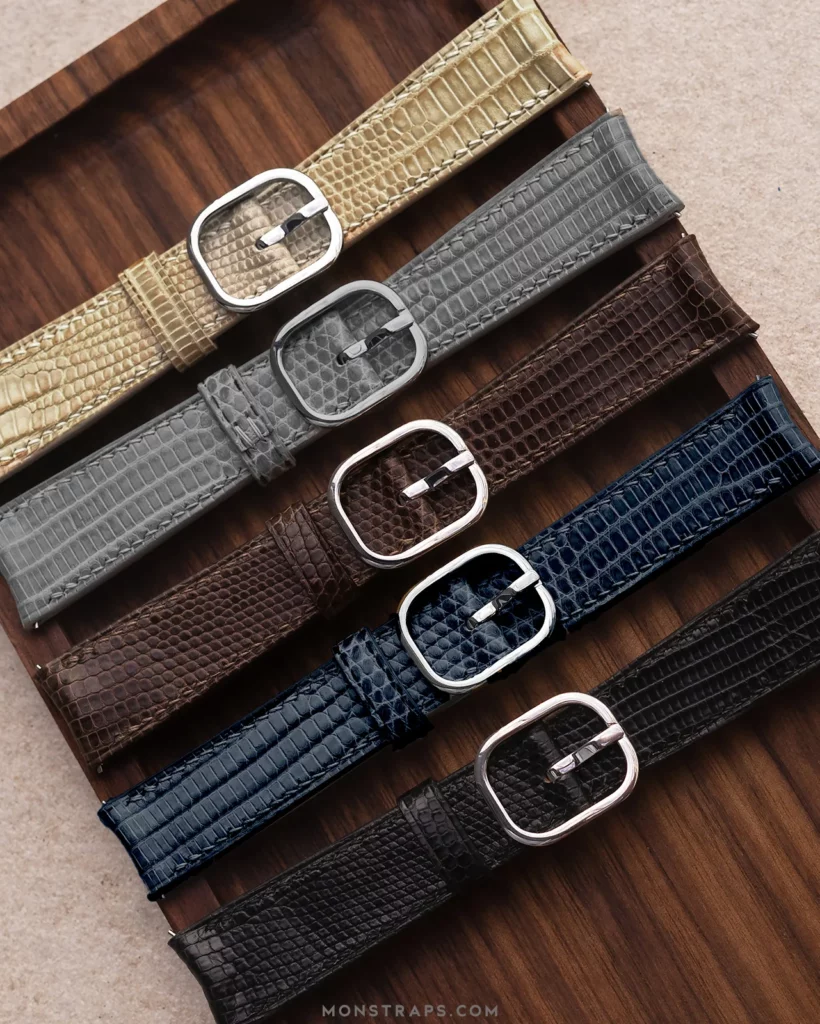
These examples show that iconic luxury goods achieve status through a synergy between leather characteristics and product purpose or brand philosophy. The leather is integral to the item’s identity and appeal.
Expert Tip: The choice of leather for an iconic product is rarely accidental. It’s a deliberate fusion of the material’s inherent properties with the brand’s identity and desired user experience.
The Value of Leather
High-quality leather items may seem costly, but this reflects enduring value beyond raw materials. Investing in premium leather means investing in exceptional durability, timeless style, meticulous craftsmanship, and often, a more considered approach to consumption.
Factors Influencing Cost and Value Several key elements contribute to the pricing of luxury leather goods. Rarity and origin of the hide play a significant role; for instance, exotic leathers from crocodile or ostrich are rarer and costlier than standard hides like calfskin. Even with standard hides, quality varies based on animal rearing conditions and origin. The quality of tanning and processing is another factor, with artisanal methods like vegetable tanning being more expensive than industrial chrome tanning. Craftsmanship, including the skill and time invested in hand-cutting and hand-stitching, adds to the cost. Finally, brand reputation and markup for established luxury houses like Hermès or Chanel also influence the price.
As highlighted, “The quality of the materials used can significantly impact the value… The rarity and difficulty of sourcing these materials also impacts the overall value”. Furthermore, “Leather is more expensive because of the intricate and labour-intensive processes involved… skilled craftsmanship… contribute to leather products’ durability, beauty, and longevity, justifying their higher cost”.
Long-Term Benefits The initial investment in high-quality leather pays dividends over time. Its unmatched durability means premium leather goods withstand daily use far better than alternatives, reducing replacements. Classic leather designs possess timeless style, remaining fashionable for years. Moreover, high-quality leather develops a unique patina and character with age, transforming items into cherished companions with increased emotional value.
Sustainability Considerations The conversation around luxury is increasingly intertwined with sustainability. High-quality leather offers compelling advantages here. Its longevity reduces waste compared to “fast fashion” items. There’s a growing emphasis on responsible and ethical sourcing, with certifications from bodies like the Leather Working Group (LWG) becoming important. LWG audits tanneries on environmental performance, chemical management, and traceability. Lancel, for example, states that since Spring-Summer 2024, over 90% of their leathers have been certified. For exotic leathers, adherence to CITES is crucial for legal and sustainable sourcing, often from regulated farms.
Choosing leather from brands prioritizing these ethical practices allows consumers to invest in luxury that aligns with their values.
Conclusion: The Importance of Understanding Leather
Luxury leather is far more than its physical parts. Its historical prestige lends inherent status. Its unique intrinsic qualities—durability, patina development, aesthetic versatility, and tactile richness—set it apart.
The meticulous craftsmanship speaks to a dedication to artistry. Understanding diverse grades and types of leather allows for choices aligned with use and expression. Tanning and finishing further refine these materials for specific needs.
For designers, product developers, brand custodians, or discerning consumers, this deep understanding is key to making informed decisions, appreciating true quality, creating enduring value, communicating authenticity, and championing responsibility.
Leather’s reign as the top choice for luxury goods is a testament to its multifaceted excellence. By embracing the details, you can fully harness the power and beauty of this extraordinary material.
Key Takeaway: Choose leather knowledgeably. Understand its grade, type, tanning, finishing, and story. This leads to products of greater integrity, beauty, and lasting value.
Essential Leather Care Guide
Proper care is essential to maintain the beauty and longevity of luxury leather items. General principles apply, with specific advice for delicate types.
General Leather Care To care for your leather goods, regularly clean them by gently wiping with a soft, dry, or slightly damp cloth to remove surface dust and dirt; avoid harsh chemicals. Periodically condition the leather with a high-quality product suitable for its type to keep it moisturized and prevent cracking, always testing on an inconspicuous area first. Protect your items with a waterproofing or stain-repellent spray designed for leather, again testing first. When storing, use the provided dust bag and keep items in a cool, dry place away from direct sunlight and heat, stuffing bags with acid-free tissue to maintain shape. For spills, act immediately by gently blotting (not rubbing) with a clean, absorbent cloth; consult a professional for stubborn stains.
Specific Care for Delicate Leathers
Aniline Leather: This leather is extremely sensitive. For general wiping, use a soft cloth very lightly dampened with distilled water; professional help is recommended for stains, and harsh cleaners should be avoided. Condition with products specifically for aniline leather to maintain softness and prevent drying. While protective sprays can mitigate staining, aniline is very absorbent and not waterproof; keep it away from direct sunlight to prevent fading. Its beauty lies in its natural state, and patina development is part of its charm.
Lambskin Leather: Lambskin is very delicate. Wipe gently with a dry or slightly damp soft cloth; a high-quality leather conditioner can sometimes lift light marks. Regular conditioning with a product for delicate leathers is crucial to keep it supple. Use a silicon-free leather protector specifically for delicate leathers; standard waterproofers can destroy lambskin. Always store in its dust bag, away from sunlight and moisture, and handle with care. Professional cleaning is often necessary for significant stains or damage.
Suede Leather: Regularly use a soft suede brush to remove loose dirt and restore the nap. A suede eraser can be effective for dry stains. For heavier soiling, a liquid suede cleaner may be used (test first). Suede generally doesn’t require conditioning. Crucially, apply a suede protector spray regularly. Avoid water for cleaning if possible; if wet, dry naturally and then brush.
Nubuck Leather: Similar to suede, use a nubuck brush or sponge to gently remove dirt and lift the nap. A nubuck eraser can be used for marks. Traditional conditioners are usually avoided. Regularly apply a nubuck protector spray. Nubuck is also sensitive to water and oils; act quickly on spills.
Exotic Leathers: These leathers (crocodile, python, etc.) often require very specific care. Dust gently with a soft, dry cloth, always wiping in the direction of the scales for reptile skins. Avoid water and chemicals. For anything beyond light dusting, consult a professional leather care specialist experienced with the specific exotic type, as incorrect products can cause irreparable damage. Some exotics may benefit from specialized conditioners, but this should be done by an expert. Store carefully in dust bags, away from extreme conditions.
By investing time in proper care, your luxury leather goods will remain beautiful and functional for many years.
